Earlier this month, the computer that controls the Hubble Space Telescope suddenly went down and NASA is still trying to figure out why.
Despite attempting to fix the computer three times, NASA engineers aren’t having any luck and are starting to see this incident as one that is mysterious and potentially intentional.
The Hubble Space Telescope was launched into orbit by a space shuttle named Discovery on April 24, 1990. Its job is to photograph planets, stars and galaxies, which have led to over a million observations and discoveries.
Over the years, it has captured things such as the death and birth of stars, galaxies that are billions of light-years away and comet pieces crashing into Jupiter. See below for some of the most beautiful sights captured by the telescope.



Not only are these photos beautiful to look at, but they’ve also helped build our understanding of space to where it is today and have given us the foundation to build upon our space technology and understanding of the universe.
Hubble is solar-powered, orbits at about 540 kilometres above Earth, is the length of a large school bus and weighs about as much as two adult elephants. It also travels at 5 miles per second, which translates to almost 30,000 kilometres p/h.
The computer in question was built in the 1980s and it acts as the telescope’s brain; controlling and monitoring instruments on the Hubble spacecraft.
NASA engineers are currently at work, trying to analyse and fix the Hubble’s computer. Although they’re not really sure what went wrong, initial data indicated that the issue could stem from a computer-memory module that was degrading, so they tried switching to one of its three backup modules, without any luck.
The team then tried to bring both the current module and backup online, both of which failed.
According to an update released by NASA, the Hubble team “will be running tests and collecting more information on the system to further isolate the problem”, while the Hubble is being kept in its “safe-mode” in order to protect the beloved instrument.
As of yet, nothing is wrong with the telescope itself, just its computer.
The good news? NASA’s 31-year-old satellite has a backup computer, which engineers can resort to if the crashed computer has gone beyond repair. After a week of trouble-shooting and “no definitive timeline” or answer for the Hubble being fixed, this might be the only option.
We wish it all the best for a speedy recovery.
Read more stories from The Latch and subscribe to our email newsletter.







